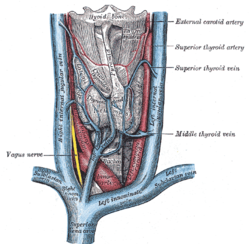Thyroid ima artery
| Thyroid ima artery | |
|---|---|
 The veins of the thyroid gland (thyroid ima artery not labeled, but region is visible.) | |
| Details | |
| Source | Brachiocephalic, others |
| Supplies | Thyroid gland, trachea |
| Identifiers | |
| Latin | Arteria thyreoidea ima |
| TA98 | A12.2.04.005 |
| TA2 | 4180 |
| FMA | 3936 |
| Anatomical terminology | |
The thyroid ima artery (the thyroidea ima artery), the thyroid artery of Neubauer, the arteria thyreoidea ima, or the lowest thyroid artery is an additional artery that supplies the thyroid gland, with the main supply being from the inferior and superior thyroid arteries. The artery also supplies the trachea, and the parathyroid gland in rare cases. The artery has also been reported to be the only source to the thyroid gland or as a compensatory artery. The artery mostly arises from the brachiocephalic trunk, though it may also originate from other sources. It also varies in size, blood supply, and termination. The artery occurs in only 3-10% of the population and because of the variations, the artery may cause surgical complications such as severe bleeding and hemorrhage.
Etymology
Thyroid ima artery was first defined by Neubauer in the year 1772. Hence, it was named the thyroid artery of Neubauer.[1]
Arteria thyreoidea ima is the Latin name of the artery.[2][3]
The artery originates lower than the inferior thyroid arteries, so it is also known as the lowest thyroid artery.[4][3]
Anatomy
The artery is an embryonic artery and it occurs because of failure of closure of the vessel; remains as a patent artery.[5] It is postulated that thyroid ima artery was originally a part of the vascular network that connected the brachiocephalic, aortic and carotid arteries.[6] It mostly arises from the brachiocephalic trunk.[2] It ascends in front of the trachea in the superior mediastinum to the lower part of the thyroid gland.[5] The artery sometimes also originates from the arch of aorta, the right common carotid, the subclavian, the pericardiacophrenic artery, the thyrocervical trunk, the transverse scapular or the internal thoracic artery.[7]
It differs greatly in size; from as small as accessory thyroid arteries to the size of inferior and superior thyroid arteries. The diameter of the lumen of the artery ranges from 3mm to 5mm.[8] The artery may be present as an accessory thyroid artery but sometimes appear to compensate for deficiency or absence of one of the primary thyroid vessels.[9] Since it begins from below the thyroid gland and ascends upwards, it is mostly associated with absence of the inferior thyroid artery. In such cases, it is known as the accessory inferior thyroid artery.[8] In rare cases, the artery is also reported to be present as the only supply to the thyroid gland in absence, deficiency or incompetence of both the superior and inferior thyroid arteries.[9]
The thyroid ima's chief supply is the thyroid gland, though it also supplies the trachea. In cases of enlargement of the parathyroid gland, the artery is also reported to supply it. The artery ends by supplying the thyroid gland, or parathyroid glands in rare cases, as a single unit or as multiple branches.[9]
Clinical significance
It is only present in approximately 3-10% of the population.[4][3] Thytoid ima artery is of surgical importance; due to its small size location, infrequent presence, and unfixed origin and course, it can cause problems while performing thoracic, tracheal, thyroid or parathyroid surgeries,[10] especially during tracheostomy and thyroidectomy.[8] Because of the artery being relatively smaller than the other thyroid arteries and having an origin from one of the big vessels, a brisk while performing the surgery may cause complications such as significant blood loss and hemorrhage.[10][11] The artery, if dissected, may draw back into the mediastinum and further complicate the condition by causing hemorrhage and clots in the thoracic cavity.[12]
References
- ^ C. Neubauer (1786). De arteria thyreoidea ima rariare arteriae innominate ramo. pp. 291–296, 309–314.
- ^ a b Henry Gray (2015). Susan Standring (ed.). Gray's Anatomy: The Anatomical Basis of Clinical Practice (41st ed.). Elsevier Health Sciences. p. 1026. ISBN 978-0-7020-6851-5.
- ^ a b c Keith L. Moore; Arthur F. Dalley (1999). Clinically Oriented Anatomy. Lippincott Williams & Wilkins. p. 1027. ISBN 978-0-683-06141-3.
- ^ a b BD Chaurasia (2012). Garg, Krishna; Mittal, PS; Chandrupatla, Mrudula (eds.). BD Chaurasia's Human Anatomy: Head-Neck and Brain. Vol. Vol. 3 (6th ed.). CBS Publishers. p. 143. ISBN 978-81-239-2332-1.
{{cite book}}:|volume=has extra text (help) - ^ a b "Thyroidea ima artery (anatomy)". General Practice Notebook. Retrieved 21 January 2016.
- ^ Dharwal K. (2009). "The Thyrothymic Trunk: a collateral vessel to the thyroid and the thymus". People's Scientific Research. 2 (2): 31–33.
- ^ Ronald A. Bergman; Adel K. Afifi; Ryosuke Miyauchi. "Thyroidea Ima (of Neubauer) Artery". Anatomy Atlases. Retrieved 21 January 2016.
- ^ a b c G. Wyatt Pratt (1916). "The Thyroidea Ima Artery". Journal of Anatomy. 50 (Pt 3): 239–242.
- ^ a b c A G Krudy; J L Doppman; M F Brennan, eds. (1980). Radiology. Vol. Vol. 136. doi:10.1148/radiology.136.1.7384523.
{{cite book}}:|volume=has extra text (help) - ^ a b Sagaya Raj; Azeem Mohiyuddin; Shuaib Merchant; Rijo M Jayaraju; Beauty Sasidharan (2014). "Thyroidea Ima Artery: A Report of Two Cases". International Journal of Head and Neck Surgery. 5 (2): 89–90.
- ^ Vishram Singh (2012). P. Mahalingam (ed.). Clinical and Surgical Anatomy (2nd ed.). Elsevier Health Sciences. pp. 301–303. ISBN 978-81-312-0303-3.
- ^ N. Anthony Moore; William A. Roy (2010). Rapid Review Gross and Developmental Anatomy. Elsevier Health Sciences. p. 220. ISBN 0-323-08048-0.
